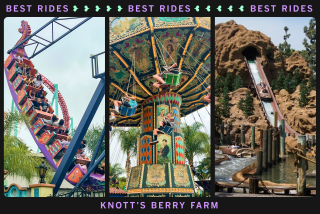A Slow but Full Circle for Relic
- Share via
BURLINGTON, Colo. — It began with the suggestion from a local wheat farmer, “Why not save the thing?”
The colorful wreckage uncovered in the dilapidated building at the Kit Carson County Fairgrounds had become home to generations of mice, pigeons and snakes. Corn and feed had been stored there. Its contents were in such a state that some considered burning the whole mess to the ground.
But they didn’t. That was 1937, the first time the turn-of-the-century carousel and its menagerie of wooden lions, tigers, armored horses, donkeys, deer, camels, goats, giraffes and a dog were saved.
The second time was more of a slow-motion resurrection. Begun as a bicentennial project, the painstaking journey of restoration has spanned 25 years, swept up a rural county and inexorably enveloped the lives of people living quietly on the edge of the Great Plains.
“In the beginning, it was the carousel to people around here,” said Jo Downey, the sunny and determined woman who is the carousel’s volunteer director. “Over time people began to call it our carousel. It belongs to them now and they are proud of it.”
The beautiful hand-carved relic fell into the hands of just the sort of people who could care for it and its strange, magical beasts. Thanks to their careful revival of the carousel, the people of this agricultural county (population 7,371) tucked just this side of the Kansas border have become a national model for historic conservation on a shoestring.
The Kit Carson County Carousel is now a National Historic Landmark, owing to its status as the oldest, virtually unaltered, carousel built by the Philadelphia Toboggan Co. in 1905. It’s one of only 160 wooden carousels operating in North America, and it’s accompaniment, an ornate 1912 Wurlitzer Monster Military Band Organ, is believed to be the only one of its kind still operating.
After restoring practically every aspect of the carousel, reconstructing the organ and retouching the 45 vintage oil paintings that enclose the center drive machinery, the people here dedicated their beloved carousel over the weekend, at long last.
If they knew then what they know now, few doubt the project would have ever gotten underway.
They simply had no idea what it would take--more than $2 million--to overcome nearly 100 years of wear and neglect. Even after the county resolved to tackle the project, each stage of the restoration, even simply replacing a worn part, took up to a year before funding was found.
“Ignorance and poverty prevented us from doing a lot of damage,” said Downey, laughing. “We didn’t have the money, so we had to go slowly, and that helped. We did things the right way, not that we knew what we were doing.”
Doing things right meant retaining the original paint on the 46 animals and ensuring each aspect of the restoration was historically accurate.
Just the process of removing the yellowed varnish turned into a chemistry project for Will Morton, the Denver sculptor who watched his artwork fall by the wayside in the quarter-century he toiled bringing the carousel’s animals back to life. Through trial and error, Morton came up with a formula to dissolve the varnish without damaging the fragile original paint. He worked gingerly, using cotton balls and Q-tips.
The job took over Morton’s life, as it did others’. In the early years of the restoration, Morton moved into a small apartment in Burlington. To be near the animals, he said. He took a bus home to Denver on weekends to see his family.
Morton, like many who have worked on the project, said he’s a different, better person because of his association with the carousel and the people who care for it.
“It’s been wonderfully enjoyable,” he said. “There are all kinds of perks--living in Burlington. I became a citizen. Getting to know these people, they are lifelong friends. They are really the salt of the earth.
“There is maybe a little more honesty, a little more integrity than you might find in a bigger place. They don’t have the tradition of an easy life. It’s difficult to be in agriculture and always has been.”
Finding the money was tough in the beginning. It meant prodigious, nickel-and-dime fund-raising: car washes, bake sales, door-to-door visits by the 4H club and lots of cans on store counters around town.
“The way they did it, the care they took is remarkable,” said Terry Blake, executive secretary of the National Carousel Assn. “And they did it in an area where, let’s face it, they ain’t wealthy.
“Jo Downey could con anything off anyone. And she’s one of my dearest friends.”
Downey was deputized as the chief fund-raiser by virtue of her job as executive director for the council of local governments. The seed money of $5,000 came from the state in 1975.
Then Downey had to get creative and persuasive. Eventually, she began writing grants and became adept at finding money--from the state preservation fund, a host of nonprofit foundations and some wealthy donors.
The Kit Carson County Carousel has had a strange odyssey. It was built for the Denver amusement park Elitch Gardens. The animals did their counterclockwise summer march there until the carousel was sold in 1928, along with the band organ, to Kit Carson County.
For $1,200, the county commissioners bought the carousel for the fairgrounds. But the tightfisted citizens of Kit Carson were not so taken with the idea and criticized the commissioners for their extravagance in such hard times. The electorate had the final word: Of the three commissioners who authorized the purchase, one did not seek reelection and the two others were defeated.
The carousel was shut down in 1931, when the Depression forced suspension of the county fair. The carousel and its animals remained entombed in their building until the fair resumed in 1937.
Over the years, the cost for riding the carousel has risen from a nickel to a quarter. The carousel directors have rejected every effort to raise the price, saying children need full access to the attraction, which is open between Memorial Day and Labor Day. High season comes during the county fair and the Little Britches Rodeo, when 12-year-old cowboys jangle over to ride the wild-looking Indian pony, only after first removing their tiny spurs.
The carousel has become so much a part of the community that hearts were broken when, in 1981, an antique theft ring swiped three horses and a donkey. A ransom fund was quickly raised, and the FBI got involved. The beloved animals were recovered in Salina, Kan., and were returned to their places after being marched through town in a welcome home parade.
This weekend’s festivities brought the farming community back to the fairgrounds and the fierce wooden animals. Rides were free, a brass band played and for now, the long work is finished.
Gazing at the building full of exotic animals, Downey tried to explain the specialness of the carousel.
“It’s not the most elaborate,” she said, ticking off an invisible list. “It’s not the oldest. It’s not the largest. . . . It’s just ours.”
More to Read
Sign up for The Wild
We’ll help you find the best places to hike, bike and run, as well as the perfect silent spots for meditation and yoga.
You may occasionally receive promotional content from the Los Angeles Times.







